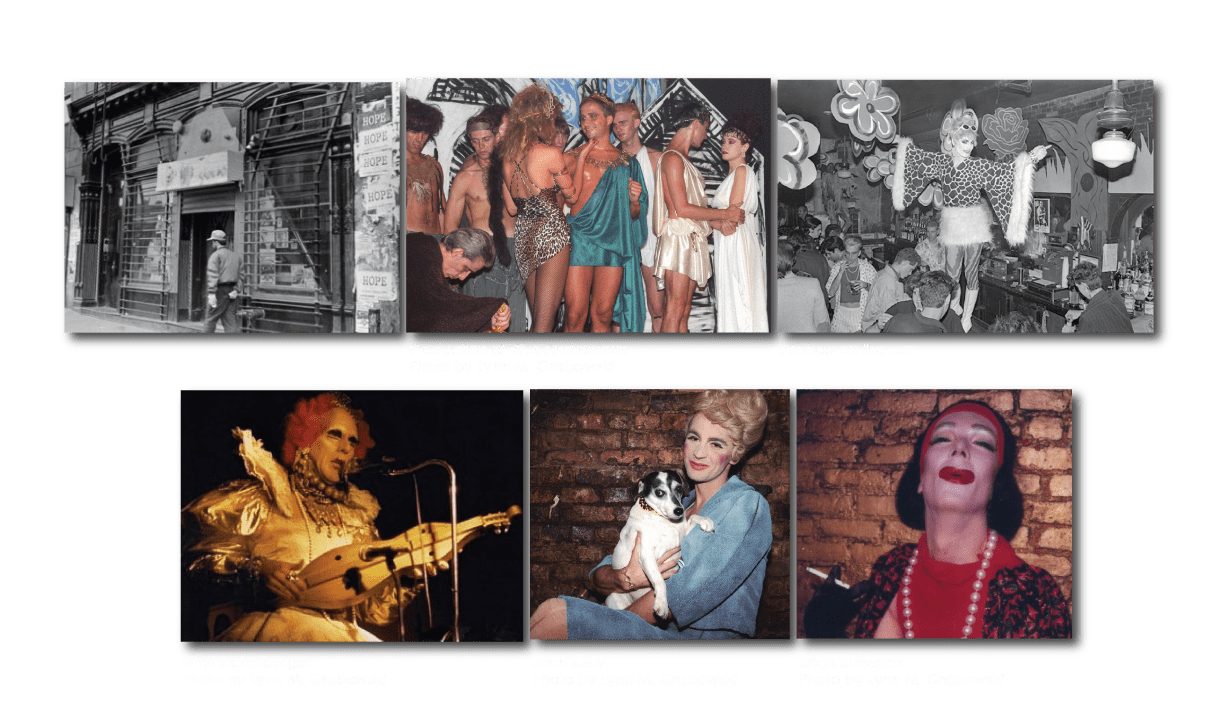


In 1981, Bobby Bradley, Alan Mace and Victor Sapienza – employees of Interferon, a high-profile
but mainstream club catering to a “bridge-and-tunnel” crowd – received permission from the
owner of the bar at 101 Avenue A to throw a party in the largely unused back room. At the event,
they were able to create an atmosphere of excitement for a crowd of experienced club goers with
a combination of factors: a fun crowd of hip people, good music, short performances that
interrupted the dancing, and performers dancing on the bar in drag. The go-go dancers were
costumed in an unusually ambiguous drag, self-consciously playing with the idea of gender.
Among the performers for the opening party were John Kelly and Phoebe Legere, both later
regulars on the Pyramid schedule.
Their party was a resounding success and soon they were booking bands and performances at the
bar every night. All of the elements included in that first party – great music, a hip crowd, short
performances breaking up the dancing, and dancers in drag on the bar – were carried over to the
club itself. Brian Butterick was hired as security but soon became Bradley’s assistant, booking
bands for Black Tuesday, devoted to alternative music. As the Pyramid schedule became more
ambitious, each night of the week acquired its own distinctive personality and attracted a
particular crowd. Pyramid devoted Sunday’s to Café Iguana, an evening of off-beat cabaret acts.
Thursday nights were usually “theme parks,” total-club events in which the audience was
surrounded by an environmental performance. Fridays and Saturdays, when the largest crowds
were expected, popular bands performed.
From June 1982 to June 1983, Monday nights were exclusively devoted to sculptor and filmmaker
John Jesurun’s first attempt at theater, a weekly serial called Chang in a Void Moon. The weekly
presentation brought the first serious critical attention to the space, not only from downtown
newspapers the Village Voice and The East Village Eye, but also from theater publications Theatre
Crafts and the Drama Review. Originally intended to run for nine weeks, Chang eventually
consisted of forty episodes. The original cast included Steve Buscemi, Mark Boone Junior, Anna
Kohler, Frank Maya, John Kelly, and Ethyl Eichelberger.
Although the Pyramid was essentially a gay bar, it was quite different from those across town in the
gay enclave of the West Village. At the Pyramid, it was all right to dress up outrageously, to switch
genders at will, and to make fun of yourself. The crowd could be astonishingly diverse. The bar
dancers put as much care into their outfits as did the stage performers. For the “theme park”
evenings, the dancers would outdo each other by having the best Mexican, Japanese, Outer
Space, Civil War, or Trailer Park outfit of the night. In addition to the drag-oriented performers and
cutting-edge bands, the Pyramid presented a constantly changing vaudeville of unusual acts. To
attract the attention of an audience that just moments before stopped dancing, the most
successful acts had one thing in common – an extremity in size, volume, shock value, or just sheer
nerve. For example, Stephen Tashjian, who performed under the name Tabboo, punctuated his
“patriotic tribute” to America by setting stuffed poodles on fire and throwing them through a hoop.
Unlike the other performance spaces that sprang up in the neighborhood, the Pyramid was also a
dance club, with its own star deejays and a distinctive mix of the latest dance music and
rediscovered older dance tunes.
When Chang in a Void Moon ended its run, a number of different kinds of theatrical productions
began to fill the Monday night stage, featuring work by Ann Magnusun, John Kelly, John Sex, Mark
Oates, Bill Rice, Steve Buscemi, Mark Boone Junior, and members of what would eventually
become Watchface. Another serial performance took focus for a five week run, director Kestutis
Nakas’ bloody but comedic version of Shakespeare’s Titus Andronicus – one act per week.
Many of Watchface’s earliest performances were created specifically for the Pyramid Club,
including House of Jahnke, Camden, Boys Will Be Men, and Stereotype. The Pyramid’s accepting
attitude and Bobby Bradley’s encouragement gave Watchface an incubator in which to develop
their style.
After the early days of experimentation, The Pyramid Club became most known for its wide range
of drag performance. Sunday nights were home to Whispers, modeled on a suburban gay disco
and hosted by Hapi Phace and Hattie Hathaway (Brian Butterick). Other notable drag performers
included John Kelly, Lypsinka, RuPaul, Lady Bunny, and Ethyl Eichelberger. Ethyl was a character
actor and wig stylist who specialized in portraying great women of history – Nefertiti, Lucretia
Borgia, Catherine the Great, Mary Todd Lincoln – using outrageous costumes, original songs, and
manically-paced monologues. A decade older than most of the other drag performers, she was
referred to as the “Queen Mother.”
1984 brought the Pyramid Club increased media attention from the The Wall Street Journal, People
magazine, and television’s Entertainment Tonight among others. This in turn brought larger, less
tolerant crowds to the Pyramid. As the decades passed, the Pyramid became more an institution
associated with gay culture – though only once or twice a week – and a place to hear bands or
dance. Its 80’s nights, meant to capitalize on its heyday, remained popular into the new millennium.
The Greenwich Village Society for Historical Preservation was successful in its campaign to have
101 Avenue A landmarked for its architectural significance, its importance as a German social club
when the neighborhood was called Kleine Deutschland, and the cultural significance of the
Pyramid Club. Kestutis Nakas and Brian Butterick are currently completing their oral history of the
Pyramid Club, We Started a Nightclub.
Watchface performances at Pyramid Club:
1984: The Future Repeats
Boys Will Be Men
Camden
House of Jahnke
National Enquirer
Negotiations
Of Little Women
Stereotype